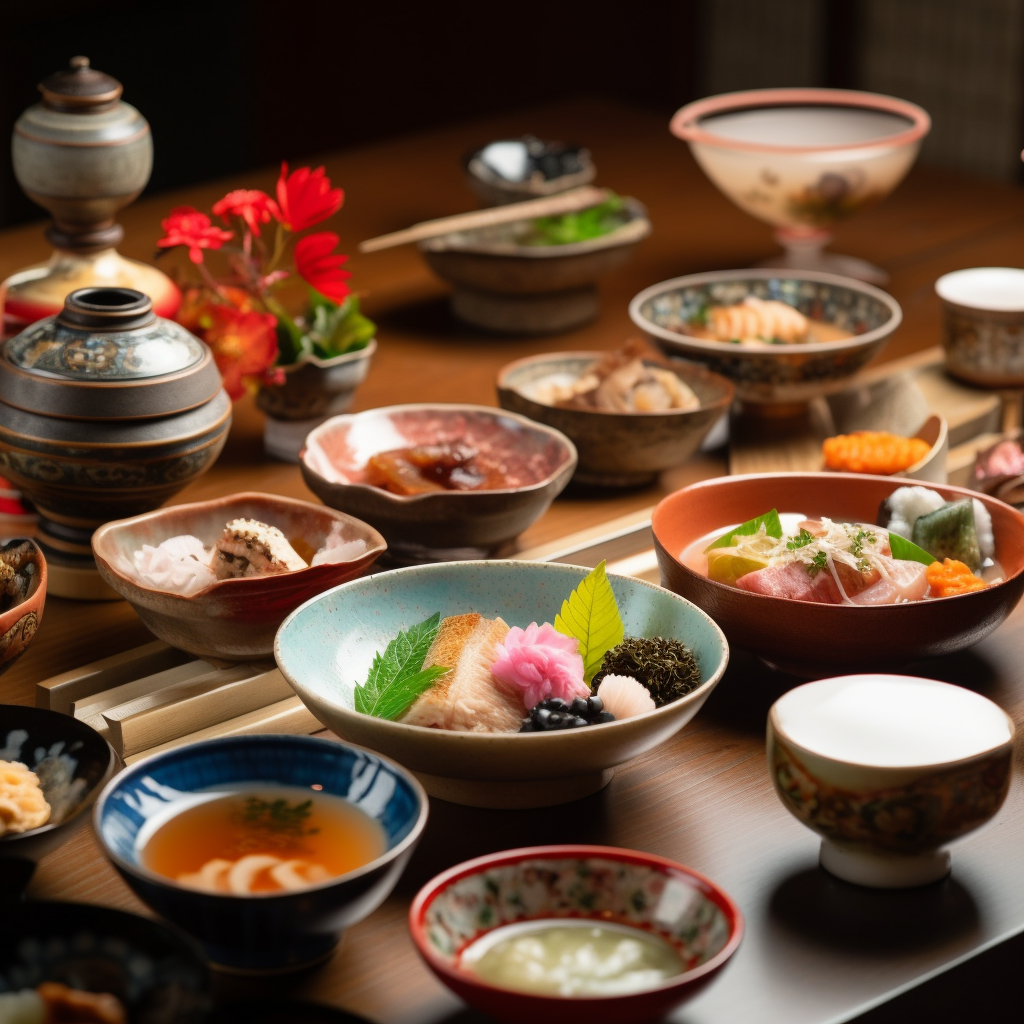The world of Japanese cuisine is vast and diverse, with a rich history and a wide variety of regional dishes. One of the most refined and sophisticated types of Japanese cuisine is Kaiseki, a traditional multi-course meal that originated in Kyoto. In this blog post, we will delve into the world of Kaiseki and Kyoto cuisine, exploring their history, key components, and unique characteristics.
A Brief History of Kaiseki and Kyoto Cuisine
Kaiseki cuisine has its roots in the Japanese tea ceremony, where a light meal was served before the tea to ensure that guests were not too hungry to fully appreciate the tea’s delicate flavors. Over time, this simple meal evolved into a more elaborate and sophisticated dining experience, incorporating elements of the local Kyoto cuisine.
Kyoto cuisine, also known as Kyo-ryori, has a history spanning more than a thousand years. As the former capital of Japan, Kyoto has long been the center of the country’s culinary and cultural traditions. The city’s cuisine is characterized by its refined taste, beautiful presentation, and emphasis on seasonal ingredients.
The Structure of a Kaiseki Meal
A traditional Kaiseki meal consists of multiple courses, each carefully crafted to showcase the finest seasonal ingredients and the chef’s skill in preparation and presentation. The number of courses can vary, but a typical Kaiseki meal includes the following dishes:
- Sakizuke (先附け) – An appetizer served with a small cup of sake
- Hassun (八寸) – A platter of seasonal ingredients, often including seafood, vegetables, and other delicacies
- Mukozuke (向付け) – A seasonal sashimi dish
- Takiawase (煮合わせ) – Simmered vegetables and protein, such as fish or tofu
- Yakimono (焼き物) – Grilled fish or meat
- Nimono (煮物) – A simmered dish, typically featuring vegetables and protein
- Agemono (揚げ物) – Deep-fried items, such as tempura
- Sunomono (酢の物) – Vinegared dishes, often featuring vegetables or seafood
- Shiizakana (強肴) – A substantial dish, such as hot pot or sukiyaki
- Gohan (御飯) – Rice, often seasoned with seasonal ingredients
- Ko no mono (香の物) – Pickled vegetables
- Tome-wan (止椀) – A soup, typically miso soup
- Mizumono (水物) – A dessert, often fruit or a delicate Japanese sweet
The Artistry of Kaiseki Cuisine
One of the most striking aspects of Kaiseki cuisine is its focus on presentation. Each dish is carefully arranged to create a visually stunning experience, often incorporating elements of nature such as leaves, flowers, or stones. The serving vessels are also an essential part of the presentation, with many Kaiseki chefs choosing exquisite ceramics, lacquerware, or glassware to showcase their culinary creations.
The ingredients used in Kaiseki cuisine are of the highest quality, often sourced from local producers or specialty purveyors. Chefs pay close attention to the seasonality of ingredients, using only the freshest produce, fish, and meat available at any given time. This focus on seasonality not only ensures the best flavor and texture but also allows diners to appreciate the
changing beauty of nature through their meal.
In addition to using the finest ingredients, Kaiseki chefs employ a wide range of cooking techniques to showcase their culinary skills. From delicate steaming and simmering to precise grilling and frying, each dish is expertly prepared to bring out the natural flavors and textures of the ingredients. This attention to detail extends to the seasoning of the dishes, with Kaiseki chefs often using subtle and harmonious combinations of flavors to create a truly memorable dining experience.
Kyoto Cuisine and its Unique Characteristics
Kyoto cuisine, as a subset of Kaiseki, shares many of the same principles and techniques. However, there are a few key differences that set it apart. One notable feature of Kyoto cuisine is its emphasis on vegetables, particularly those grown in the surrounding region. These vegetables, known as Kyo-yasai, are prized for their unique flavors and textures, and feature prominently in many Kyoto dishes.
Kyoto is also known for its tofu and yuba (tofu skin), both of which are often used in Kaiseki meals. These delicate soy-based products are made with the mineral-rich water from the city’s rivers, which gives them a distinctively smooth and delicate texture.
Another characteristic of Kyoto cuisine is the use of delicate, subtle flavors. This is in part due to the influence of the tea ceremony, as well as the city’s long history of catering to the refined tastes of the imperial court. Dishes in Kyoto cuisine often feature light broths, subtle seasonings, and an emphasis on the natural flavors of the ingredients.
Experiencing Kaiseki and Kyoto Cuisine
If you have the opportunity to visit Japan, we highly recommend experiencing a Kaiseki meal in Kyoto. There are many Kaiseki restaurants in the city, ranging from centuries-old establishments to modern, innovative interpretations of the tradition. While the cost of a Kaiseki meal can be quite high, the unparalleled quality of the ingredients, the skill of the chefs, and the beautiful presentation make it a truly unforgettable dining experience.
In conclusion, Kaiseki and Kyoto cuisine represent the pinnacle of Japanese culinary art, showcasing the finest ingredients, expert cooking techniques, and stunning presentation. For those looking to immerse themselves in the rich culture and history of Japan, a Kaiseki meal in Kyoto is an experience not to be missed.

コメントを残す